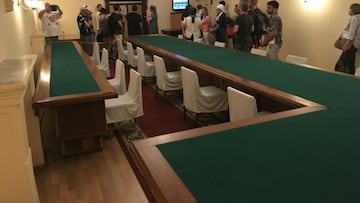Stalin's bunker an unlikely site for Russia's World Cup charm offensive
With no World Cup action to speak of in Samara on Friday, Joseph Stalin's bunker hideout proved a popular tourist destination.

They say sport and politics should never mix, but as Samara enjoyed a break from World Cup action on Friday, a visit to Joseph Stalin's top-secret bunker was an opportunity not to be missed.
The notorious dictator, who presided over the Soviet Union for 12 years in the mid-20th century, had the hideout constructed in the event of German invasion during World War Two.
Built 37 metres below street level, the bunker consists of a number of rooms - including a private office for the man himself - so that the top officials would have a safe retreat had Adolf Hitler's Nazis reached as far as Moscow.
Although that threat never quite materialised and Stalin remained defiantly in the capital, some of his government leaders were evacuated in 1941 and set up camp in Samara - then known as Kuybyshev - approximately 1,000 kilometres to the south-east.
And 77 years later, on the anniversary of Germany's invasion of the Soviet Union, football fans from around the world queued up to get a glimpse of the underground hideaway.
Used today’s down time to take in a visit to Stalin’s bunker, built 37 metres underground as a hideout from the threat of German invasion. pic.twitter.com/G1TQIvtfed
— Harry West (@West1882) June 22, 2018
Squeezing past each other on the narrow stairways, supporters from Australia - who saw their side draw with Denmark at Samara Arena on Thursday - and Uruguay, who face the hosts at the same venue on Monday, stopped to take pictures of the conference room, Stalin's personal office and other areas adorned with information displays.
Tour guide Helen Konovalova, of the Samara Tourist Board, explained the bunker was kept under such strict secrecy that its existence was only uncovered when the Soviet Union broke up 50 years later.
"This bunker was constructed in top secret so nobody knew about it until 1991, only when the regime changed in our country, and we were really surprised to see such a unique construction in the city centre," she told Omnisport.
"Besides, the bunker still belongs to the army, you can't come just any day you wish and visit it as a museum. You have to book your visit beforehand and get permission to come....only [now people can come] for the FIFA World Cup, so now everybody who wishes can come here and visit the bunker.
"And people who live in Samara, locals, they've heard nowadays everybody can come here so not only foreigners but Russian speaking tourists now come to the bunker."
— Harry West (@West1882) June 22, 2018
And Konovalova says the residents of Samara hope the bunker, although an unusual tourist attraction, will inspire people to encourage others to look upon Russia as a destination worth visiting, even after the World Cup bandwagon has packed up and moved on.
"After the World Cup we really hope that people would like to return to our country and our city and tell their relatives and friends that Russia is a good country to go to!" she added.
"The main aim of the bunker is to tell our generation about such a tragic event in our history because we mustn't forget about such events, to prevent our future from such awful things that our politicians sometimes do."

